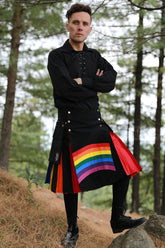St. Patrick’s Day | Myths and Traditions
Who was Saint Patrick?
Saint Patrick (circa 386-461 AD), a 5th-century Christian missionary and Bishop in Ireland, was born in Roman Britain to a wealthy romanized family. At 16, he was kidnapped and taken to Ireland as a slave, where he spent six years before escaping. He later returned to Ireland around 432 CE to convert the Irish to Christianity. By the time of his death on March 17, 461, he had established cloisters, houses of worship, and schools, playing a crucial role in shaping the religious and cultural landscape of Ireland. Saint Patrick is also associated with using the shamrock to explain the concept of the Trinity. Despite being the patron saint of Ireland, he was actually born in Britain. His life and work are celebrated on March 17, known as Saint Patrick's Day.

When was the 1st celebration of St. Patrick’s day held?
The first celebration of St. Patrick's Day in the United States took place in 1737, organized by the Charitable Irish Society of Boston. Surprisingly, the celebration was not Catholic in nature, as Irish immigration to the colonies was dominated by Protestants. New York's first observance was held in 1762, and the first recorded parade in New York was by Irish soldiers in the British Army in 1766. The first document of this day celebration in Philadelphia was in 1771. However, the first recorded celebration in America was in St. Augustine, Florida, in the year 1600, with the first St. Patrick's Day Parade also in St. Augustine in 1601.
Why & how is St. Patrick’s Day celebrated?
This day is celebrated on March 17th to commemorate Saint Patrick and the arrival of Christianity in Ireland, celebrating Irish heritage and culture. The day has evolved into festivals worldwide, featuring dancing, special foods, and music. In Ireland, it became a public holiday in 1903, expanding the religious celebration to the secular realm. The holiday falls during the Christian season of Lent, with families attending church in the morning and celebrating in the afternoon with traditional Irish bacon and cabbage. St. Patrick, the patron saint of Ireland, was born in Britain in the 4th century and is known for his missionary work and spreading of Christianity. The celebrations we recognize today are largely a product of Irish immigrants in America, with parades and festivities spreading in major U.S. cities in the 1700s. St. Patrick's day is associated with wearing green, eating corned beef and cabbage, and attending parades, with some of these practices being adopted by the Irish themselves.

Is St. Patrick's Day celebrated globally?
This day is celebrated globally, commemorating Saint Patrick and the arrival of Christianity in Ireland. While it has religious significance in Ireland, it has evolved into a largely secular holiday of revelry and celebration of Irish heritage and culture, especially in cities with large Irish immigrant populations. The holiday's popularity is global, with celebrations in countries such as the United States, England, Canada, Argentina, Australia, New Zealand, and Japan. This day parades and revelry have spread worldwide, with the holiday being officially recognized in Ireland, Northern Ireland, Newfoundland, and the Caribbean island of Montserrat.
Where does the first parade of this day begin?
The first parade began in New York City in 1762. It was organized by Irish soldiers serving in the British army and comprised homesick Irish expatriates and military members. This event marked the beginning of a tradition that has since become widespread across the United States, with millions of Americans of Irish ancestry celebrating their cultural identity and history through St. Patrick's Day parades. Today, the NYC Parade on this day starts at 44th Street and 5th Avenue at 11 am and proceeds up the avenue to 79th Street, where millions of spectators come to celebrate.

The World's Shortest St. Patrick's Day Parade takes place on Hot Springs's 98-foot-long Bridge Street, making it the world's shortest working street. The event began in 2003 and has grown into a nationwide spectacle, attracting thousands of fun-lovers. The parade features quirky details and is accompanied by events like a Blarney Stone Kissing Contest and a street dance with a live band.
Wearing Green on St. Patrick’s day:
Wearing green on St. Patrick's Day is a tradition deeply rooted in Irish culture and folklore. The color green represents the Catholics of Ireland and is associated with the country's nickname, "The Emerald Isle." It is also influenced by the green stripe in the Irish flag. Legend has it that wearing green brings good luck and makes one invisible to leprechauns, who are known to pinch anyone they can see. This tradition has become a year-round practice for luck and is a symbol of Irish nationalism. The association of green with this Day dates back to the 18th century and has since become a widespread and fun tradition.
Why Is the Shamrock Associated With St. Patrick’s Day?
The shamrock is associated with the day because it is said that St. Patrick used the three-leafed plant to explain the Holy Trinity to the Irish people during his mission to convert them to Christianity in the 5th century. The shamrock, which is a type of clover, has three leaves that are all connected to a single stem. He used this as a metaphor for the Christian concept of the Holy Trinity, which holds that there are three persons in one God: the Father, the Son, and the Holy Spirit. The shamrock has since become a symbol of Ireland and is often used in celebrations, parades, and decorations of this day. In addition to its religious significance, the shamrock is also associated with good luck and is a popular motif in Irish folklore and culture. Many people wear shamrock pins or accessories on this day as a way to show their Irish heritage or to celebrate the holiday.

Why are leprechaun associated with St. Patrick's day?
Leprechauns are associated with St. Patrick's Day due to their deep-rooted connection to Irish folklore and culture. Originating from Ireland, both the holiday and the mythical creatures are intertwined in the country's traditions. Leprechauns, initially depicted as red, turned green to symbolize their association with Ireland. According to legend, spotting a leprechaun is considered a sign of good luck. The association between leprechauns and St. Patrick's Day has been further solidified through popular culture, such as the film "Darby O'Gill and the Little People," and the use of leprechauns as symbols of Ireland.
Does Irish Music Capture St. Patrick's Day Spirit?
This day is synonymous with Irish music, capturing the spirit of the celebration. From traditional folk tunes to rousing Irish-inflected punk, the music of the Emerald Isle sets the perfect tone for the festivities. Whether it's the classic ballad "Molly Malone" by Flogging Molly or the iconic "Sunday Bloody Sunday" by U2, Irish music embodies the essence of the day. The lively melodies and rich storytelling in songs by renowned artists like The Dubliners, The Chieftains, and Thin Lizzy create an authentic and vibrant atmosphere, making Irish music an essential part of this day experience. So, crank up the volume on these rollicking Irish songs and celebrate all night long!
Why Corned Beef & Cabbage on St. Patrick's Day?
The tradition of eating corned beef and cabbage on St. Patrick's Day is a uniquely American tradition, not an Irish one. The association of corned beef with this day can be traced back to the 19th century and the Irish immigration to the U.S. In Ireland, beef was a luxury item, and the Irish mainly consumed corned pork and relied on potatoes for sustenance. However, in the U.S., Irish immigrants found salted beef brisket to be cheap and readily available, leading to the replacement of their traditional "Irish bacon" with corned beef. Additionally, cabbage was affordable and readily available, making it a natural pairing with corned beef. As St. Patrick's Day evolved into a celebration of Irish heritage for Irish-Americans, corned beef and cabbage became a holiday tradition.

St. Patrick Church Service Elegance
The service is held on March 17, which is the traditional death date of St. Patrick. St. Patrick Church Service Elegance is a religious service that celebrates the patron saint and national apostle of Ireland, St. Patrick. The service is known for its elegance and solemnity, with beautiful hymns and prayers that honor the saint's legacy. He is credited with bringing Christianity to Ireland and is known for his spiritual autobiography, the Confessio. Although little is known about his life, his writings have come to be better understood, and they mirror a truth and simplicity of the rarest quality. The Church Service is a beautiful way to honor this important figure in Irish history and culture.
Sports Events on Saint Patrick's Day:
Saint Patrick's Day is a day of celebration in Ireland and around the world, and sports events are no exception. Traditionally, the All-Ireland Senior Club Football and Hurling Championships are hosted on this day, and the Leinster, Munster, and Ulster Schools Rugby Senior Cups are also held. Additionally, the Cheltenham Festival and Six Nations Championship often coincide with the day. In Chicago, the St. Patrick's Day celebrations include the dyeing of the Chicago River and a parade, as well as various parties and events hosted by Green Curtain Events. The Saint Patrick's Day Test, also known as the Donnybrook Cup, was an international rugby league football match played between the United States and Ireland from 1995 to 2012.
Is Chicago's Green River Tradition Sustainable?
Chicago's Green River tradition, where the river is dyed green in honor of St. Patrick's Day, has been a popular event for over 60 years. The dye used is vegetable-based and environmentally friendly, unlike the chemical-laden dye initially used in the past. However, some environmentalists argue that the tradition perpetuates the notion that rivers can be treated any way people want, rather than being protected as valuable natural resources. The Friends of the Chicago River feel that the dye allows people to believe the river isn't "natural," justifying its treatment as a sewer. Despite these concerns, the tradition continues to be popular and has inspired other cities to dye their own waterways. As environmental awareness grows, it is important to consider the impact of such traditions on the environment and to evolve them to reflect the need for protection of our land and waterways.

When is St. Patrick's day 2024?
This day is celebrated on March 17 every year, but the day of the week changes. In 2024, St. Patrick's Day falls on Sunday, March 17th.
Has the Public Celebration of this day ever been canceled?
Celebrations of this day have been canceled on several occasions. In Ireland, public festivities were canceled three times for public health reasons:
- In 2001, celebrations were postponed to May due to the foot-and-mouth outbreak.
- The centuries-old St. Patrick's Day parade in New York City was also canceled in 2020 due to the global coronavirus pandemic, marking the first time in more than 250 years that the event did not take place as planned.
- Similarly, in 2021, there were no parades in Ireland on St. Patrick's Day due to the government's highest "Level 5" restriction on businesses and the Irish public to combat the spread of the coronavirus.
FAQs
What was the religion that St. Patrick brought to Ireland?
St. Patrick is credited with bringing Christianity to parts of Ireland and was probably partly responsible for the Christianization of the Picts and other Celtic peoples.
What is the story behind the legend of St. Patrick and the well?
The legend of St. Patrick and the well is that he struck his staff on the ground and a well sprang up to provide water for his followers.
What is the truth behind the myth that St. Patrick drove all the snakes out of Ireland?
The truth behind the myth that St. Patrick drove all the snakes out of Ireland is that there were never any snakes in Ireland to begin with. It is believed that the term "snakes" may have referred to the pagan beliefs that St. Patrick helped to eradicate.
Which mythical creature is said to grant three wishes if caught?
The mythical creature that is said to grant three wishes if caught is the leprechaun.
What color was originally associated with St. Patrick’s Day?
Originally, blue was associated with St. Patrick's Day, but green is now commonly connected with the day.













